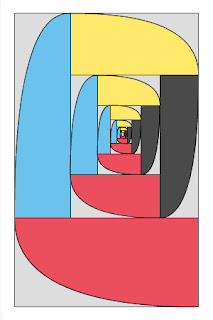
Monday, December 17, 2007
Arbitrary Rectangle Spiral

Sunday, December 16, 2007
Conceptual Art, Algorithmic Art, Generative Art
Is this conceptual art? Sol LeWitt decreed way back in in the 60s that math was out, unless it was simple. Is it possible that he had an aversion?
"Conceptual art doesn’t really have much to do with mathematics, philosophy, or nay other mental discipline. The mathematics used by most artists is simple arithmetic or simple number systems. The philosophy of the work is implicit in the work and it is not an illustration of any system of philosophy." Sol LeWitt, Paragraphs on Conceptual Art.Sometimes, my art may have too much to do with mathematics to satisfy this limitation of LeWitt’s. I reserve the right to use the most complex math I can comprehend, which is still relatively simple, to build any tool I wish for creating art.
Is it algorithmic art?
"Simply put, algorists are artists who introduce and control original algorithms in the creation of their work." Roman Verostko.Jean Pierre Hebert wrote an algoritm that separates algorists from not-algorists:
if (creation && object of art && algorithm && one's own algorithm) {The trouble I have with this is "&& algorithm" / "|| !algorithm". I employ algorithms when creating tools. They’re used when I create art. It’s a collaboration between me as a draftsman and me as a programmer. I program algorithms. I use algorithms.
include * an algorist *
} elseif (!creation || !object of art || !algorithm || !one's own algorithm) {
exclude * not an algorist *
}
Is it generative art?
Generative art is a real good term for computer generated graphics. I don’t think this fits what I’ve done to date, because each of my projects leave most of the decision making to me during the use of whatever tool or algorithm I create. With the perspectives and interactive drawing tool I make choices, arrange, and make corrections during the rendering separate from the work I do during the programming of the tools.
"Generative art refers to any art practice where the artist creates a process, such as a set of natural language rules, a computer program, a machine, or other procedural invention, which is then set into motion with some degree of autonomy contributing to or resulting in a completed work of art." Philip Galanter.That sounds a lot like:
"When an artist uses a conceptual form of art, it means that all of the planning and decisions are made beforehand and the execution is a perfunctory affair. The idea becomes a machine that makes the art." Sol LeWitt, Paragraphs on Conceptual Art.Besides, I think generative art gets boring very quickly. Fractals are to generative art as the golden rectangle is to painting. I don’t think either has that much to do with beauty, harmony, or art.
I’m O.K. with being a draftsman and a programmer. So what am I doing? Conceptual Art, Algorithmic Art, Generative Art, or something else. I keep going back to Sol LeWitt's paragraphs. Like so many other artist/theorists I think he may have bent his definitions to match his output. He made the concept fit his art. I don't think conceptual has to be simple.
Still, I'd as soon be a good draftsman as a conceptual, algorithmic, or generative artist. For one thing, the terms are limiting. For another, we have to make exceptions for each. A good programmer could be any of the three. A programmer-draftsman has the opportunity to go beyond each.
Wednesday, December 12, 2007
The Silver Means
I have edited four lines in three sections of my paper that I submitted to the JOMA. The revised version is here: "The Golden Rectangle – One Rectangle in a Continuum of Infinitely Many Similar Rectangles". On further investigation I found that I should describe the first series of rectangles in my paper as being based on the silver means which is described on the Fibonacci website of Dr. Ron Knott (http://www.mcs.surrey.ac.uk/Personal/R.Knott/Fibonacci/cfINTRO.html#silver). I should credit Knott with documenting the silver means. I had already included Knott in my references, but I should be more specific in regards to the silver means. Until yesterday, I wasn’t aware that Knott had already identified this series of numbers that are central to my paper.
The edits I am making include four lines in: the second paragraph of the Abstract; the second paragraph of the section, First Series of Similar Rectangles; and, the title of Table 1. In each case I am identifying my first series of rectangles as being based on Dr. Knott’s silver means.